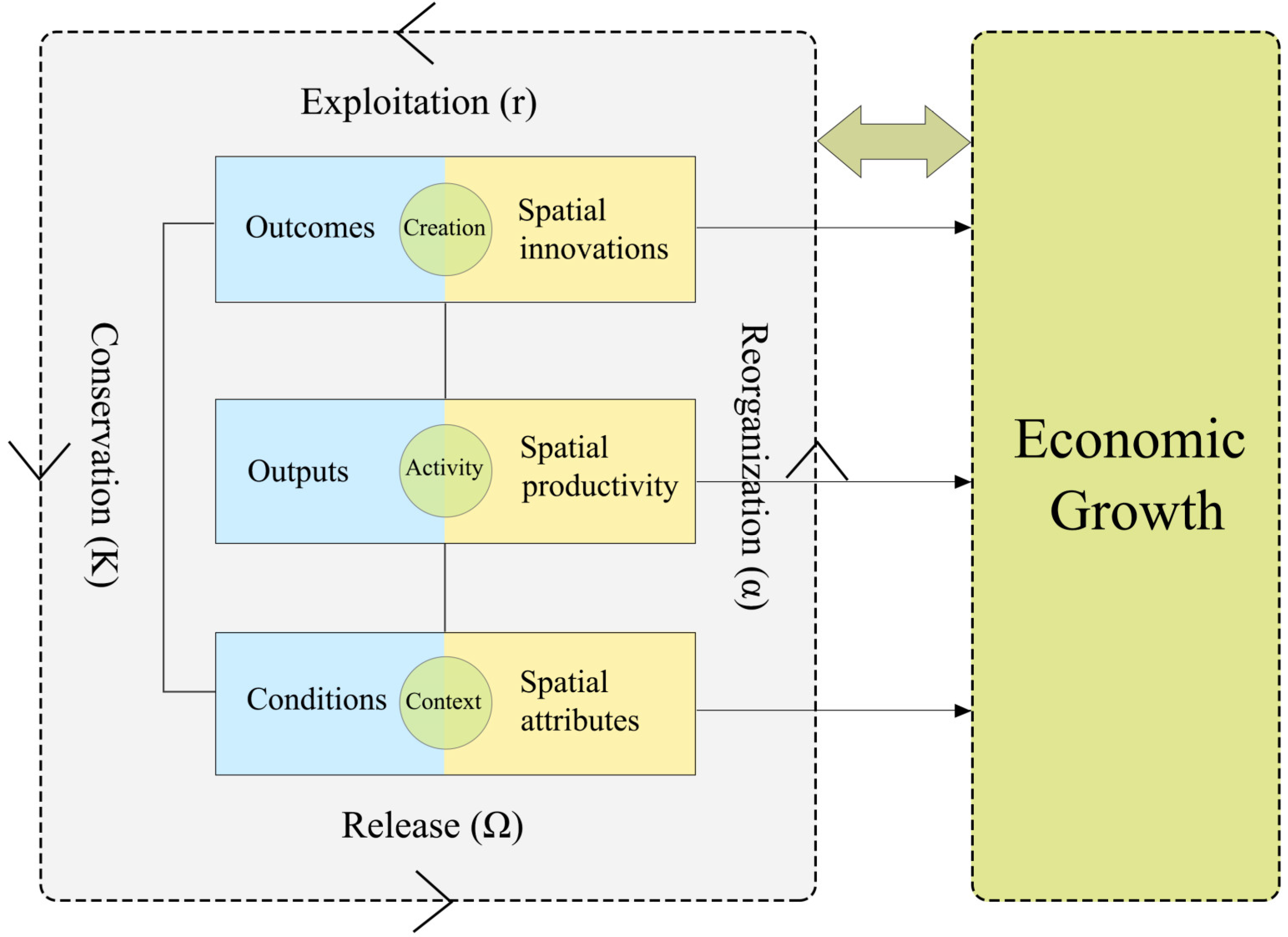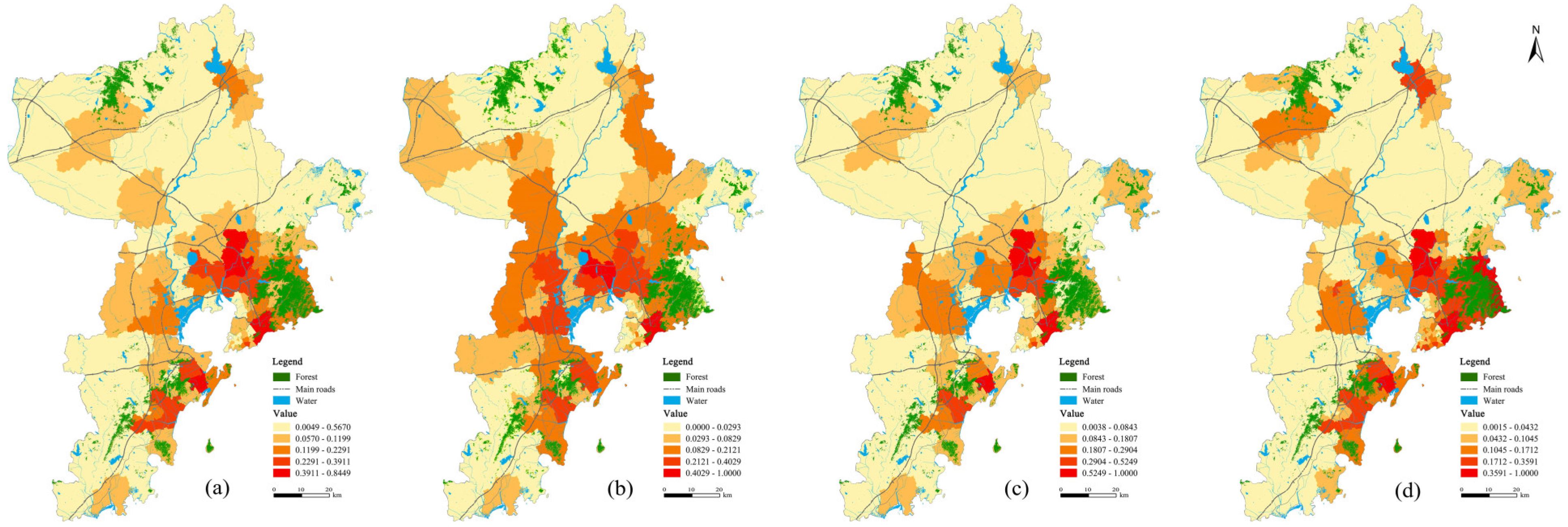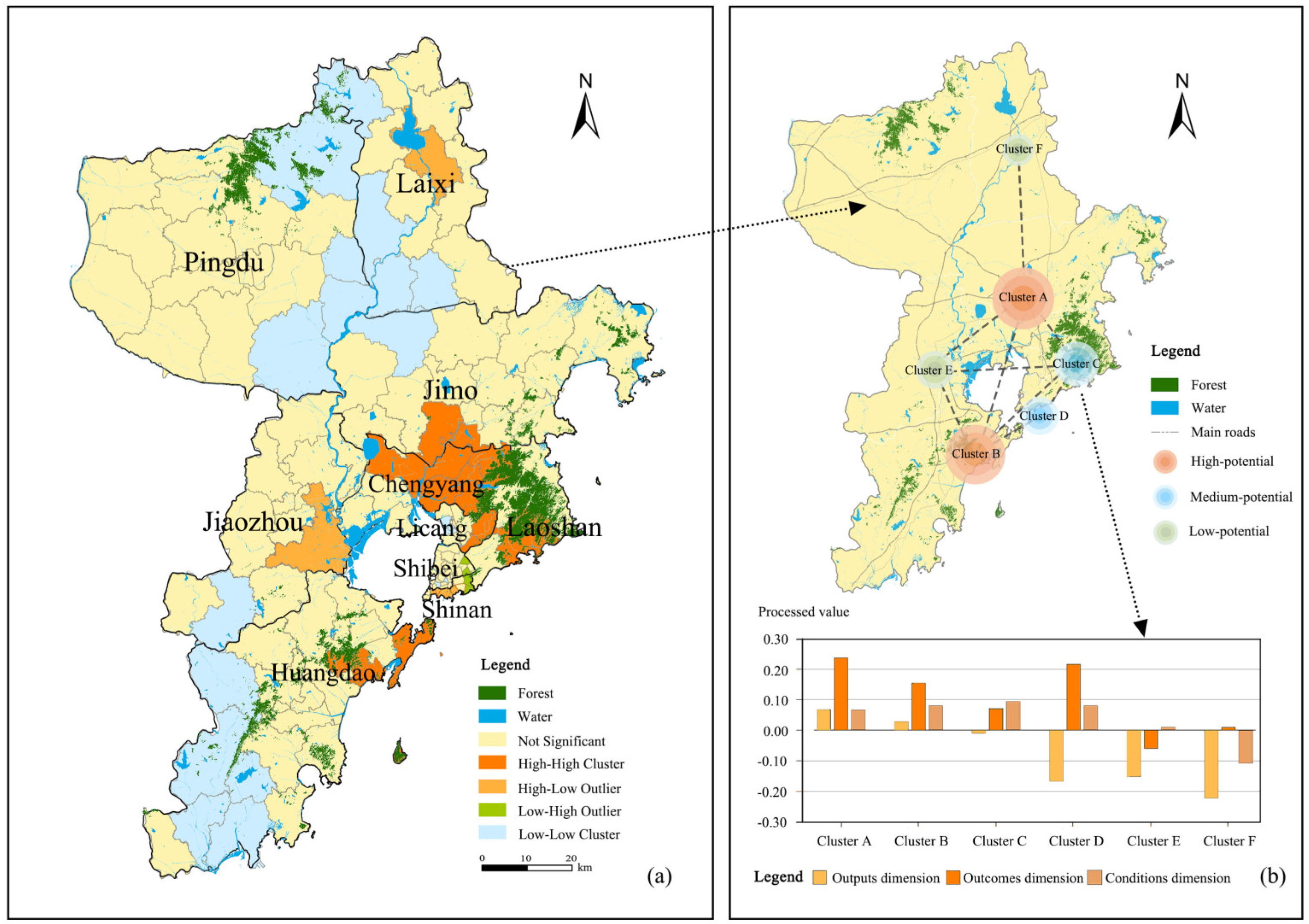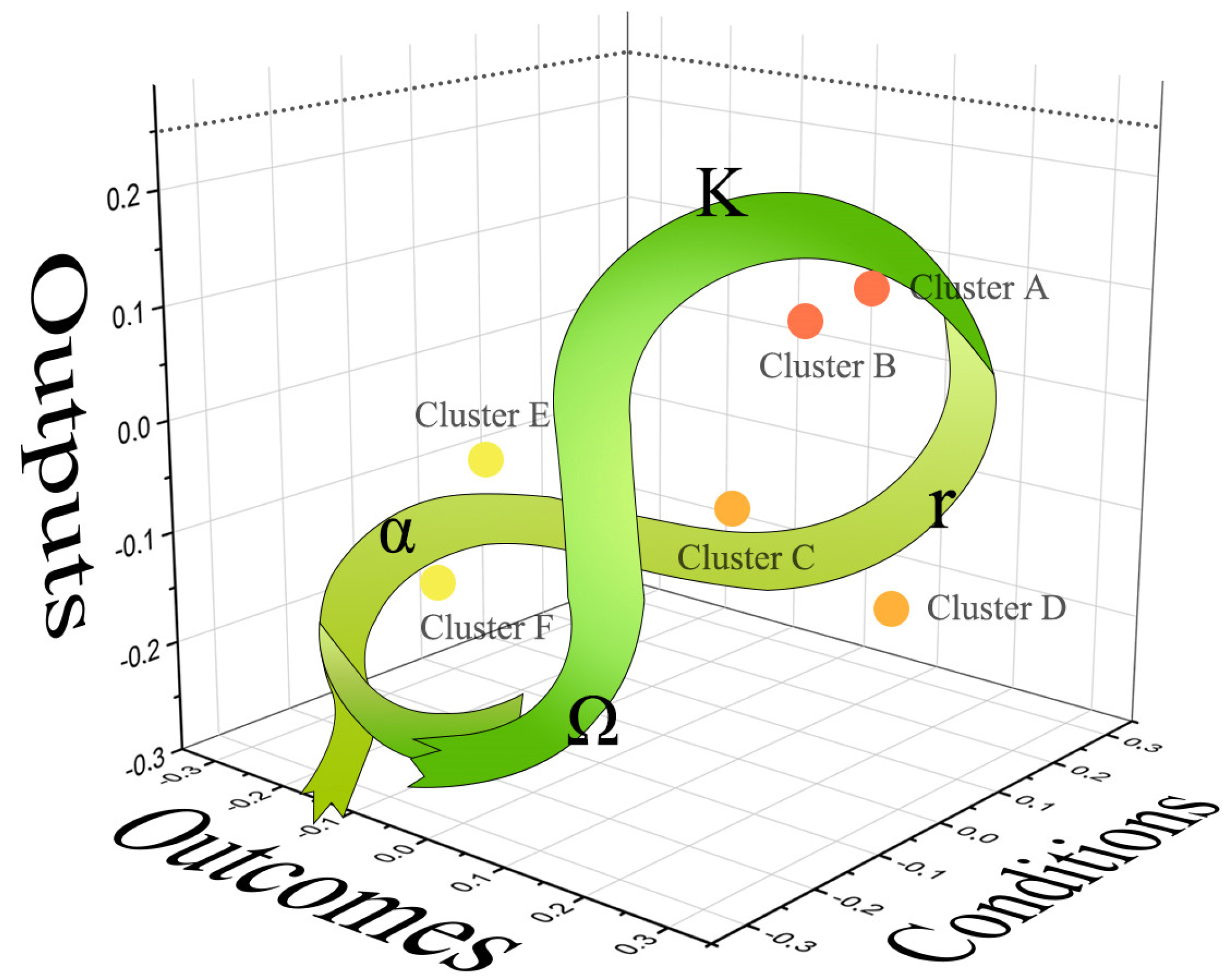Assessing the Potential for Developing Innovation Districts at the City Scale by Adapting a New Sustainable Entrepreneurial Ecosystems Method
Abstract
:1. Introduction
2. Conceptual Framework
3. Materials and Methods
3.1. Study Area and Data Sources
3.2. Methods
3.2.1. Indicator System
3.2.2. Coupling Coordination Degree Model
3.2.3. Exploratory Spatial Data Analysis (ESDA)
4. Results
4.1. Potential for Developing Innovation Districts in the Studied City
4.1.1. Potential of Subdistrict Units to Develop Innovation Districts
4.1.2. Classification of the Dominant Factors of Subdistrict Units
4.2. Potential for Developing Innovation Districts at the Cluster Scale
5. Discussion
5.1. The Features and Advantages of the Evaluation Method
5.2. Implications for Future Development and Spatial Planning
5.3. Limitations and Future Work
6. Conclusions
Author Contributions
Funding
Data Availability Statement
Acknowledgments
Conflicts of Interest
References
- Cui, M.; Pan, S.; Newell, S.; Cui, L. Strategy, Resource Orchestration and E-Commerce Enabled Social Innovation in Rural China. J. Strateg. Inf. Syst. 2017, 26, 3–21. [Google Scholar] [CrossRef]
- Hu, T.-S.; Pan, S.-C.; Lin, H.-P. Development, Innovation, and Circular Stimulation for a Knowledge-Based City: Key Thoughts. Energies 2021, 14, 7999. [Google Scholar] [CrossRef]
- Yigitcanlar, T.; Inkinen, T. Theory and Practice of Knowledge Cities and Knowledge-Based Urban Development. In Geographies of Disruption: Place Making for Innovation in the Age of Knowledge Economy; Yigitcanlar, T., Inkinen, T., Eds.; Springer International Publishing: Cham, Switzerland, 2019; pp. 109–133. [Google Scholar]
- Pancholi, S.; Yigitcanlar, T.; Guaralda, M.; Mayere, S.; Caldwell, G.A.; Medland, R. University and Innovation District Symbiosis in the Context of Placemaking: Insights from Australian Cities. Land Use Policy 2020, 99, 105109. [Google Scholar] [CrossRef]
- Liang, S. Streets Place-Making in Beijing’s Innovative Districts: From the Perspective of Public Assets and Property Rights. China City Plan. Rev. 2019, 28, 28–36. [Google Scholar]
- Hutton, T.A. The New Economy of the Inner City. Cities 2004, 21, 89–108. [Google Scholar] [CrossRef]
- Katz, B.; Wagner, J. The Rise of Innovation Districts: A New Geography of Innovation in America; Brookings Institution: Washington, DC, USA, 2014. [Google Scholar]
- Wang, J.; Tong, C.; Hu, X. Policy Zoning Method for Innovation Districts to Sustainably Develop the Knowledge-Economy: A Case Study in Hangzhou, China. Sustainability 2021, 13, 3503. [Google Scholar] [CrossRef]
- Yan, Y.-L.; He, M.; Song, L. Evaluation of Regional Industrial Cluster Innovation Capability Based on Particle Swarm Clustering Algorithm and Multi-Objective Optimization. Complex Intell. Syst. 2021, 9, 3547–3558. [Google Scholar] [CrossRef]
- Hervás-Oliver, J.-L.; Albors-Garrigos, J.; Estelles-Miguel, S.; Boronat-Moll, C. Radical Innovation in Marshallian Industrial Districts. Reg. Stud. 2018, 52, 1388–1397. [Google Scholar] [CrossRef]
- Baker, S.C.; Mehmood, A. Social Innovation and the Governance of Sustainable Places. Local Environ. 2015, 20, 321–334. [Google Scholar] [CrossRef]
- Yigitcanlar, T. Position Paper: Benchmarking the Performance of Global and Emerging Knowledge Cities. Expert Syst. Appl. 2014, 41, 4680–4690. [Google Scholar] [CrossRef]
- Esmaeilpoorarabi, N.; Yigitcanlar, T.; Guaralda, M.; Kamruzzaman, M. Does Place Quality Matter for Innovation Districts? Determining the Essential Place Characteristics from Brisbane’s Knowledge Precincts. Land Use Policy 2018, 79, 734–747. [Google Scholar] [CrossRef]
- Esmaeilpoorarabi, N.; Yigitcanlar, T.; Kamruzzaman, M.; Guaralda, M. How Does the Public Engage with Innovation Districts? Societal Impact Assessment of Australian Innovation Districts. Sustain. Cities Soc. 2020, 52, 101813. [Google Scholar] [CrossRef]
- Esmaeilpoorarabi, N.; Yigitcanlar, T.; Kamruzzaman, M.; Guaralda, M. Conceptual Frameworks of Innovation District Place Quality: An Opinion Paper. Land Use Policy 2020, 90, 104166. [Google Scholar] [CrossRef]
- Adu-McVie, R.; Yigitcanlar, T.; Erol, I.; Xia, B. Classifying Innovation Districts: Delphi Validation of a Multidimensional Framework. Land Use Policy 2021, 111, 105709. [Google Scholar] [CrossRef]
- Esmaeilpoorarabi, N.; Yigitcanlar, T.; Guaralda, M.; Kamruzzaman, M. Evaluating Place Quality in Innovation Districts: A Delphic Hierarchy Process Approach. Land Use Policy 2018, 71, 471–486. [Google Scholar] [CrossRef]
- Rapetti, C.; Pareja-Eastaway, M.; Piqué, J.M.; Grimaldi, D. Measuring the Development of Innovations Districts through Performance Indicators: 22@Barcelona Case. J. Evol. Stud. Bus. 2022, 7, 6–39. [Google Scholar] [CrossRef]
- Yigitcanlar, T.; Adu-McVie, R.; Erol, I. How Can Contemporary Innovation Districts Be Classified? A Systematic Review of the Literature. Land Use Policy 2020, 95, 104595. [Google Scholar] [CrossRef]
- Adu-McVie, R.S.; Yigitcanlar, T.; Erol, I.; Xia, B. How Can Innovation District Performance Be Assessed? Insights from South East Queensland, Australia. J. Place Manag. Dev. 2022, 16, 183–247. [Google Scholar] [CrossRef]
- Rapetti, C.; Piqué, J.M.; Figlioli, A.; Berbegal-Mirabent, J. Performance Indicators for the Evolution of Areas of Innovation: Porto Digital Case. J. Evol. Stud. Bus. 2022, 7, 219–267. [Google Scholar] [CrossRef]
- Piqué, J.M.; Berbegal-Mirabent, J.; Etzkowitz, H. Triple Helix and the Evolution of Ecosystems of Innovation: The Case of Silicon Valley. Triple Helix 2018, 5, 1–21. [Google Scholar] [CrossRef]
- Davidson, K.; Håkansson, I.; Coenen, L.; Nguyen, T.N.M. Municipal Experimentation in Times of Crises: (Re-)Defining Melbourne’s Innovation District. Cities 2022, 132, 104042. [Google Scholar] [CrossRef]
- Jones, A.L. Regenerating Urban Waterfronts—Creating Better Futures—From Commercial and Leisure Market Places to Cultural Quarters and Innovation Districts. Plan. Pract. Res. 2016, 32, 333–344. [Google Scholar] [CrossRef]
- Van Winden, W.; Carvalho, L. Urbanize or Perish? Assessing the Urbanization of Knowledge Locations in Europe. J. Urban Technol. 2016, 23, 53–70. [Google Scholar] [CrossRef]
- Jiang, S.; Hu, Y.; Wang, Z. Core Firm Based View on the Mechanism of Constructing an Enterprise Innovation Ecosystem: A Case Study of Haier Group. Sustainability 2019, 11, 3108. [Google Scholar] [CrossRef]
- Moore, J.F. Predators and Prey: A New Ecology of Competition. Harv. Bus. Rev. 1993, 71, 75–86. [Google Scholar]
- Isenberg, D.J. How to Start an Entrepreneurial Revolution. Harv. Bus. Rev. 2010, 88, 40–50. [Google Scholar]
- Jacobides, M.G.; Cennamo, C.; Gawer, A. Towards a Theory of Ecosystems. Strateg. Manag. J. 2018, 39, 2255–2276. [Google Scholar]
- Neck, H.M.; Meyer, G.D.; Cohen, B.; Corbett, A.C. An Entrepreneurial System View of New Venture Creation. J. Small Bus. Manag. 2004, 42, 190–208. [Google Scholar] [CrossRef]
- Acs, Z.J.; Stam, E.; Audretsch, D.B.; O’Connor, A. The Lineages of the Entrepreneurial Ecosystem Approach. Small Bus. Econ. 2017, 49, 1–10. [Google Scholar] [CrossRef]
- Hakala, H.; O’Shea, G.; Farny, S.; Luoto, S. Re-Storying the Business, Innovation and Entrepreneurial Ecosystem Concepts: The Model-Narrative Review Method. Int. J. Manag. Rev. 2020, 22, 10–32. [Google Scholar] [CrossRef]
- Bischoff, K.; Volkmann, C. Stakeholder Support for Sustainable Entrepreneurship—A Framework of Sustainable Entrepreneurial Ecosystems. Int. J. Entrep. Ventur. 2018, 10, 172–201. [Google Scholar] [CrossRef]
- Spigel, B. The Relational Organization of Entrepreneurial Ecosystems. Entrep. Theory Pract. 2017, 41, 49–72. [Google Scholar] [CrossRef]
- Theodoraki, C.; Dana, L.-P.; Caputo, A. Building Sustainable Entrepreneurial Ecosystems: A Holistic Approach. J. Bus. Res. 2021, 140, 346–360. [Google Scholar] [CrossRef]
- Malecki, E.J. Entrepreneurship and Entrepreneurial Ecosystems. Geogr. Compass 2018, 12, e12359. [Google Scholar] [CrossRef]
- Nicotra, M.; Romano, M.; Giudice, M.D.; Schillaci, C.E. The Causal Relation between Entrepreneurial Ecosystem and Productive Entrepreneurship: A Measurement Framework. J. Technol. Transf. 2018, 43, 640–673. [Google Scholar] [CrossRef]
- Cantner, U.; Cunningham, J.A.; Lehmann, E.E.; Menter, M. Entrepreneurial Ecosystems: A Dynamic Lifecycle Model. Small Bus. Econ. 2019, 57, 407–423. [Google Scholar] [CrossRef]
- Cao, G.-H.; Zhang, J. Is a Sustainable Loop of Economy and Entrepreneurial Ecosystem Possible? A Structural Perspective. Environ. Dev. Sustain. 2020, 23, 7002–7040. [Google Scholar] [CrossRef]
- O’Connor, A.; Audretsch, D.B. Regional Entrepreneurial Ecosystems: Learning from Forest Ecosystems. Small Bus. Econ. 2022, 60, 1051–1079. [Google Scholar] [CrossRef]
- Mukesh, H.V. Digital Transformation Taking Centre Stage: How Is Digital Transformation Reshaping Entrepreneurial Innovation? J. Entrep. 2022, 31, 364–401. [Google Scholar] [CrossRef]
- Filho, W.L.; Fritzen, B.; Vargas, V.R.; Paço, A.; Zhang, Q.; Doni, F.; Azul, A.M.; Vasconcelos, C.R.P.; Nikolaou, I.E.; Skouloudis, A.; et al. Social Innovation for Sustainable Development: Assessing Current Trends. Int. J. Sustain. Dev. World Ecol. 2021, 29, 311–322. [Google Scholar] [CrossRef]
- Stam, E. Measuring Entrepreneurial Ecosystems. In Entrepreneurial Ecosystems: Place-Based Transformations and Transitions; O’Connor, A., Stam, E., Sussan, F., Audretsch, D.B., Eds.; Springer International Publishing: Cham, Switzerland, 2018; pp. 173–197. [Google Scholar]
- Perugini, F. Space–Time Analysis of Entrepreneurial Ecosystems. J. Technol. Transf. 2022, 48, 240–291. [Google Scholar] [CrossRef]
- Cao, Z.; Shi, X. A Systematic Literature Review of Entrepreneurial Ecosystems in Advanced and Emerging Economies. Small Bus. Econ. 2020, 57, 75–110. [Google Scholar] [CrossRef]
- Neumeyer, X.; Santos, S.C. Sustainable Business Models, Venture Typologies, and Entrepreneurial Ecosystems: A Social Network Perspective. J. Clean. Prod. 2018, 172, 4565–4579. [Google Scholar] [CrossRef]
- Kitsios, F.; Kamariotou, M.; Grigoroudis, E. Digital Entrepreneurship Services Evolution: Analysis of Quadruple and Quintuple Helix Innovation Models for Open Data Ecosystems. Sustainability 2021, 13, 12183. [Google Scholar] [CrossRef]
- Ren, J.; Yang, J.; Huang, H. Research on the Innovation District Mechanism: Ecology, Subject and Space. Urban Dev. Stud. 2020, 27, 18–25. [Google Scholar]
- Auerswald, P.E.; Dani, L. The Adaptive Life Cycle of Entrepreneurial Ecosystems: The Biotechnology Cluster. Small Bus. Econ. 2017, 49, 97–117. [Google Scholar] [CrossRef]
- Yigitcanlar, T.; Guaralda, M.; Taboada, M.B.; Pancholi, S. Place Making for Knowledge Generation and Innovation: Planning and Branding Brisbane’s Knowledge Community Precincts. J. Urban Technol. 2016, 23, 115–146. [Google Scholar] [CrossRef]
- Xu, F.C.; Wu, L.; Evans, J.A. Flat Teams Drive Scientific Innovation. Proc. Natl. Acad. Sci. USA 2022, 119, e2200927119. [Google Scholar] [CrossRef]
- García-Terán, J.; Skoglund, A. A Processual Approach for the Quadruple Helix Model: The Case of a Regional Project in Uppsala. J. Knowl. Econ. 2019, 10, 1272–1296. [Google Scholar] [CrossRef]
- Shi, X.; Chen, Y.; Xia, M.; Zhang, Y. Effects of the Talent War on Urban Innovation in China: A Difference-in-Differences Analysis. Land 2022, 11, 1485. [Google Scholar] [CrossRef]
- Shi, J.; Lai, W.-H. Fuzzy Ahp Approach to Evaluate Incentive Factors of High-Tech Talent Agglomeration. Expert Syst. Appl. 2022, 212, 118652. [Google Scholar] [CrossRef]
- Granstrand, O.; Holgersson, M. Innovation Ecosystems: A Conceptual Review and a New Definition. Technovation 2020, 90–91, 102098. [Google Scholar] [CrossRef]
- Thai, Q.H.; Mai, K.N.; Do, T.T. An Evolution of Entrepreneurial Ecosystem Studies: A Systematic Literature Review and Future Research Agenda. SAGE Open 2023, 13, 1. [Google Scholar] [CrossRef]
- Mack, E.A.; Mayer, H. The Evolutionary Dynamics of Entrepreneurial Ecosystems. Urban Stud. 2016, 53, 2118–2133. [Google Scholar] [CrossRef]
- Audretsch, D.B.; Cunningham, J.A.; Kuratko, D.F.; Lehmann, E.E.; Menter, M. Entrepreneurial Ecosystems: Economic, Technological, and Societal Impacts. J. Technol. Transf. 2018, 44, 313–325. [Google Scholar] [CrossRef]
- Haarhaus, T.; Strunk, G.; Liening, A. Assessing the Complex Dynamics of Entrepreneurial Ecosystems: A Nonstationary Approach. J. Bus. Ventur. Insights 2020, 14, e00194. [Google Scholar] [CrossRef]
- Gotts, N.M. Resilience, Panarchy, and World-Systems Analysis. Ecol. Soc. 2007, 12, 24. [Google Scholar] [CrossRef]
- Feng, L.; Lu, J.; Wang, J. A Systematic Review of Enterprise Innovation Ecosystems. Sustainability 2021, 13, 5742. [Google Scholar] [CrossRef]
- Lin, X.; Lu, M. Report on Evaluation of China Innovation Cities. Stat. Res. 2009, 26, 3–9. [Google Scholar]
- Pancholi, S.; Yigitcanlar, T.; Guaralda, M. Attributes of Successful Place-Making in Knowledge and Innovation Spaces: Evidence from Brisbane’s Diamantina Knowledge Precinct. J. Urban Des. 2018, 23, 693–711. [Google Scholar] [CrossRef]
- Cheah, S.L.-Y.; Ho, Y.P. Building the Ecosystem for Social Entrepreneurship: University Social Enterprise Cases in Singapore. Sci. Technol. Soc. 2019, 24, 507–526. [Google Scholar] [CrossRef]
- Uçar, E. Local Creative Culture and Corporate Innovation. J. Bus. Res. 2018, 91, 60–70. [Google Scholar] [CrossRef]
- Carayannis, E.G.; Campbell, D.F.J.; Grigoroudis, E. Helix Trilogy: The Triple, Quadruple, and Quintuple Innovation Helices from a Theory, Policy, and Practice Set of Perspectives. J. Knowl. Econ. 2021, 13, 2272–2301. [Google Scholar] [CrossRef]
- Yu, C.; Wang, T.; Gu, X. Collective Reputation Cognition, Network Competence and Enterprise Innovation Performance. Manag. Decis. 2022, 60, 567–588. [Google Scholar] [CrossRef]
- Pradhan, R.P.; Maradana, R.P.; Dash, S.; Zaki, D.B.; Gaurav, K.; Jayakumar, M.N. Venture Capital, Innovation Activities, and Economic Growth: Are Feedback Effects at Work? Innovation 2017, 19, 189–207. [Google Scholar] [CrossRef]
- Li, Y.; Wang, J.; Liu, Y.; Long, H. Spatial Pattern and Influencing Factors of the Coordination Development of Industrialization, Informatization, Urbanization and Agricultural Modernization in China: A Prefecture Level Exploratory Spatial Data Analysis. Acta Geogr. Sin. 2014, 69, 199–212. [Google Scholar]
- Li, C. China’s Multi-Dimensional Ecological Well-Being Performance Evaluation: A New Method Based on Coupling Coordination Model. Ecol. Indic. 2022, 143, 109321. [Google Scholar] [CrossRef]
- Zhu, Y.; Tang, C.; Sun, R.; Lei, J. Evaluation of China Science and Technology Innovation City Based on System Coupling. Sci. Technol. Manag. Res. 2019, 39, 10. [Google Scholar]
- Xu, Z.; Chau, S.N.; Chen, X.; Zhang, J.; Li, Y.; Dietz, T.; Wang, J.; Winkler, J.A.; Fan, F.; Huang, B.; et al. Assessing Progress Towards Sustainable Development over Space and Time. Nature 2020, 577, 74–78. [Google Scholar] [CrossRef]
- Getis, A. The Analysis of Spatial Association by Use of Distance Statistics. Geogr. Anal. 2010, 24, 189–206. [Google Scholar] [CrossRef]
- Symanzik, J. Exploratory Spatial Data Analysis. In Handbook of Regional Science; Fischer, M.M., Nijkamp, P., Eds.; Springer: Berlin/Heidelberg, Germany, 2014; pp. 1295–1310. [Google Scholar]
- Shen, L.; Huang, Z.; Wong, S.W.; Liao, S.; Lou, Y. A Holistic Evaluation of Smart City Performance in the Context of China. J. Clean. Prod. 2018, 200, 667–679. [Google Scholar] [CrossRef]
- Notice on the Issuance of the Implementation Rules for Promoting Postdoctoral Innovation and Entrepreneurship in Qingdao City. Available online: http://www.qingdao.gov.cn/zwgk/xxgk/rlshbz/gkml/gwfg/202205/t20220523_6067388.shtml (accessed on 10 August 2023).
- Liyanage, S.I.H.; Netswera, F.G. Greening Universities with Mode 3 and Quintuple Helix Model of Innovation–Production of Knowledge and Innovation in Knowledge-Based Economy, Botswana. J. Knowl. Econ. 2022, 13, 1126–1156. [Google Scholar] [CrossRef]
- Ren, J.; Hu, X.; Yu, L. “Industry, City, Innovation” Integrated Development Model. Planners 2018, 9, 94–99. [Google Scholar]
- Wang, J.; Zhang, X. Land-Based Urbanization in China: Mismatched Land Development in the Post-Financial Crisis Era. Habitat Int. 2022, 125, 102598. [Google Scholar] [CrossRef]
- Wang, Y.; Duan, X.; Wu, K. The Dilemma and Outlet of the Industry Transformation and Upgrading of the City’s “Vacating Cage to Change Birds”: Based on the Investigation and Study in Beijing. Sci. Geogr. Sin. 2020, 40, 786–792. [Google Scholar]






| Criteria | Indicator | Weight | Criteria | Indicator | Weight |
|---|---|---|---|---|---|
| Conditions | Commercial network density | 0.1178 | Outputs | Number of SMEs per square kilometer | 0.2208 |
| Degree of functional mix | 0.1783 | Percentage of corporate R&D personnel | 0.1394 | ||
| Green area per capita | 0.1262 | Number of key laboratories per square kilometer | 0.1596 | ||
| Number of technical cooperation bases per square kilometer | 0.1304 | Number of university campuses per square kilometer | 0.1112 | ||
| Number of advanced service enterprises per square kilometer | 0.1470 | Number of science and technology parks per square kilometer | 0.1964 | ||
| Number of co-working spaces per square kilometer | 0.1901 | Number of venture capital institutions per square kilometer | 0.1726 | ||
| Number of cultural exchange venues per square kilometer | 0.1102 | ||||
| Outcomes | innovation output value per capita | 0.6666 | |||
| Number of patents grants per capita | 0.3334 |
| Category | Area Ratio (%) | Subcategory | Coupling Characteristics | Quantity (Pieces) |
|---|---|---|---|---|
| Category I | 20.08% | Ia | High -High -High | 15 |
| Category II | 22.04% | IIa | High -High -Low | 5 |
| IIb | Low -High -High | 16 | ||
| IIc | High -Low -High | 2 | ||
| Category III | 57.16% | IIIa | High -Low -Low | 14 |
| IIIb | Low -High -Low | 12 | ||
| IIIc | Low -Low -High | 8 |
| Category | Value Interval | Development Phase | Counter Measures |
|---|---|---|---|
| High potential (Cluster A and Cluster B) | [0.3736, 0.3376] | Conservation (K) phase | Maintain the current level and make up for the shortcomings |
| Medium potential (Cluster C and Cluster D) | [0.2771, 0.3015] | Exploitation (r) phase | Take advantage of the environment and facilities to attract talented people, promote industrial upgrading, and realize the re-prosperity of space |
| Low potential (Cluster E and Cluster F) | [0.1435, 0.1847] | Reorganization (α) phase | Stabilize existing platforms and absorb external advantages to achieve leapfrog development |
Disclaimer/Publisher’s Note: The statements, opinions and data contained in all publications are solely those of the individual author(s) and contributor(s) and not of MDPI and/or the editor(s). MDPI and/or the editor(s) disclaim responsibility for any injury to people or property resulting from any ideas, methods, instructions or products referred to in the content. |
© 2023 by the authors. Licensee MDPI, Basel, Switzerland. This article is an open access article distributed under the terms and conditions of the Creative Commons Attribution (CC BY) license (https://creativecommons.org/licenses/by/4.0/).
Share and Cite
Xu, C.; Du, Y.; Qi, L.; Li, R.; Yang, Z. Assessing the Potential for Developing Innovation Districts at the City Scale by Adapting a New Sustainable Entrepreneurial Ecosystems Method. Buildings 2023, 13, 2572. https://doi.org/10.3390/buildings13102572
Xu C, Du Y, Qi L, Li R, Yang Z. Assessing the Potential for Developing Innovation Districts at the City Scale by Adapting a New Sustainable Entrepreneurial Ecosystems Method. Buildings. 2023; 13(10):2572. https://doi.org/10.3390/buildings13102572
Chicago/Turabian StyleXu, Congbao, Yujia Du, Liyan Qi, Ruiqian Li, and Zhen Yang. 2023. "Assessing the Potential for Developing Innovation Districts at the City Scale by Adapting a New Sustainable Entrepreneurial Ecosystems Method" Buildings 13, no. 10: 2572. https://doi.org/10.3390/buildings13102572






